MKT3031: Analysis of Tesco's Entrepreneurial Strategy Report
VerifiedAdded on 2023/01/10
|11
|3468
|68
Report
AI Summary
This report provides a thorough analysis of Tesco's entrepreneurial strategies, examining its rationale, background, and market position. It delves into the company's strategic situation, capabilities, and market positioning using frameworks like PESTLE and VRIO analyses. The report evaluates a range of entrepreneurial strategies, including market penetration, market development, product development, and diversification, as outlined by the Ansoff matrix. It further explores Tesco's market positioning strategy and provides a conclusion summarizing the key findings. The report offers valuable insights into Tesco's success and strategic choices within the retail sector, making it a valuable resource for students studying entrepreneurial strategy. The report also includes an introduction, main body, and conclusion with references.

Choose a good topic
Paraphrase This Document
Need a fresh take? Get an instant paraphrase of this document with our AI Paraphraser
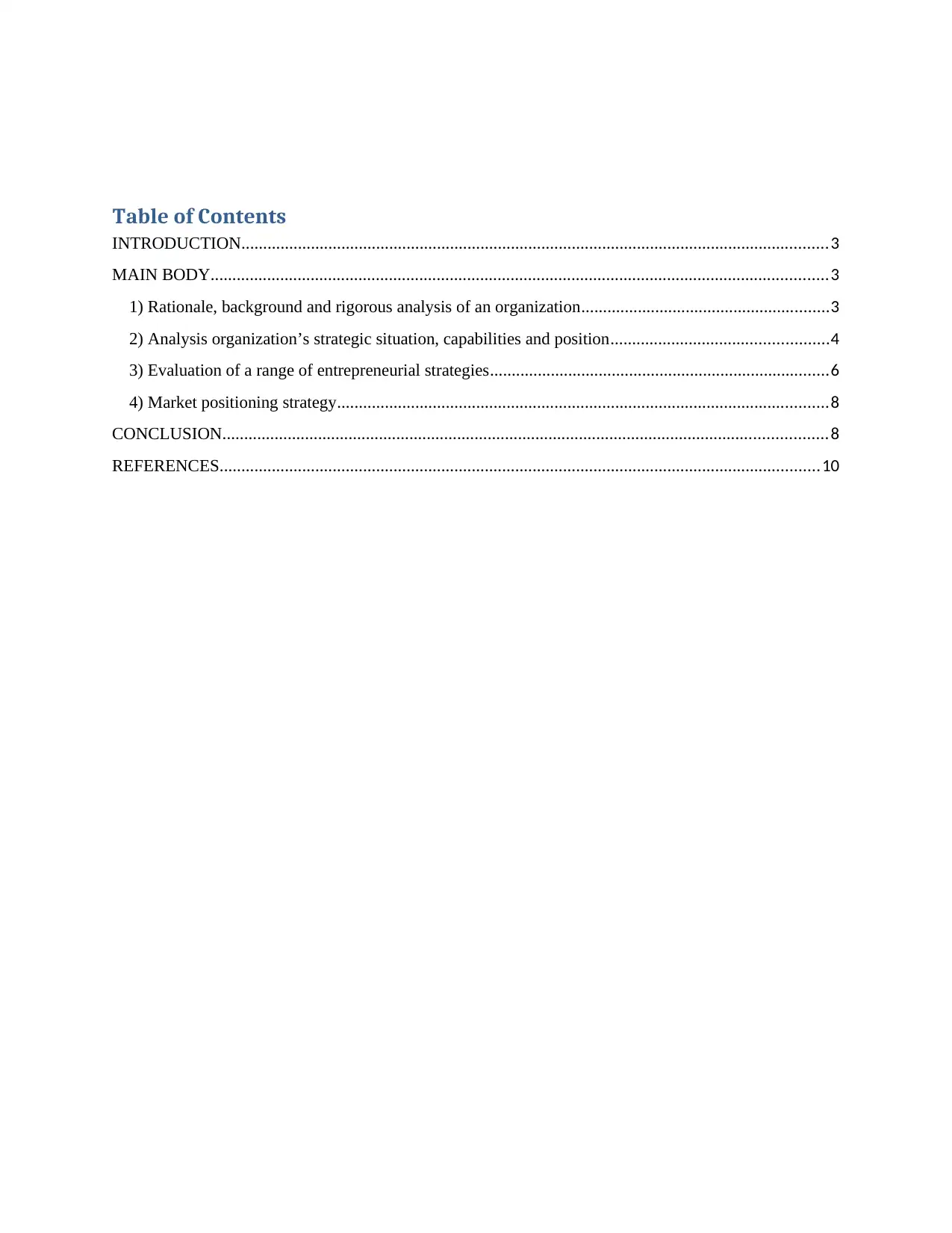
Table of Contents
INTRODUCTION.......................................................................................................................................3
MAIN BODY..............................................................................................................................................3
1) Rationale, background and rigorous analysis of an organization.........................................................3
2) Analysis organization’s strategic situation, capabilities and position..................................................4
3) Evaluation of a range of entrepreneurial strategies..............................................................................6
4) Market positioning strategy.................................................................................................................8
CONCLUSION...........................................................................................................................................8
REFERENCES..........................................................................................................................................10
INTRODUCTION.......................................................................................................................................3
MAIN BODY..............................................................................................................................................3
1) Rationale, background and rigorous analysis of an organization.........................................................3
2) Analysis organization’s strategic situation, capabilities and position..................................................4
3) Evaluation of a range of entrepreneurial strategies..............................................................................6
4) Market positioning strategy.................................................................................................................8
CONCLUSION...........................................................................................................................................8
REFERENCES..........................................................................................................................................10
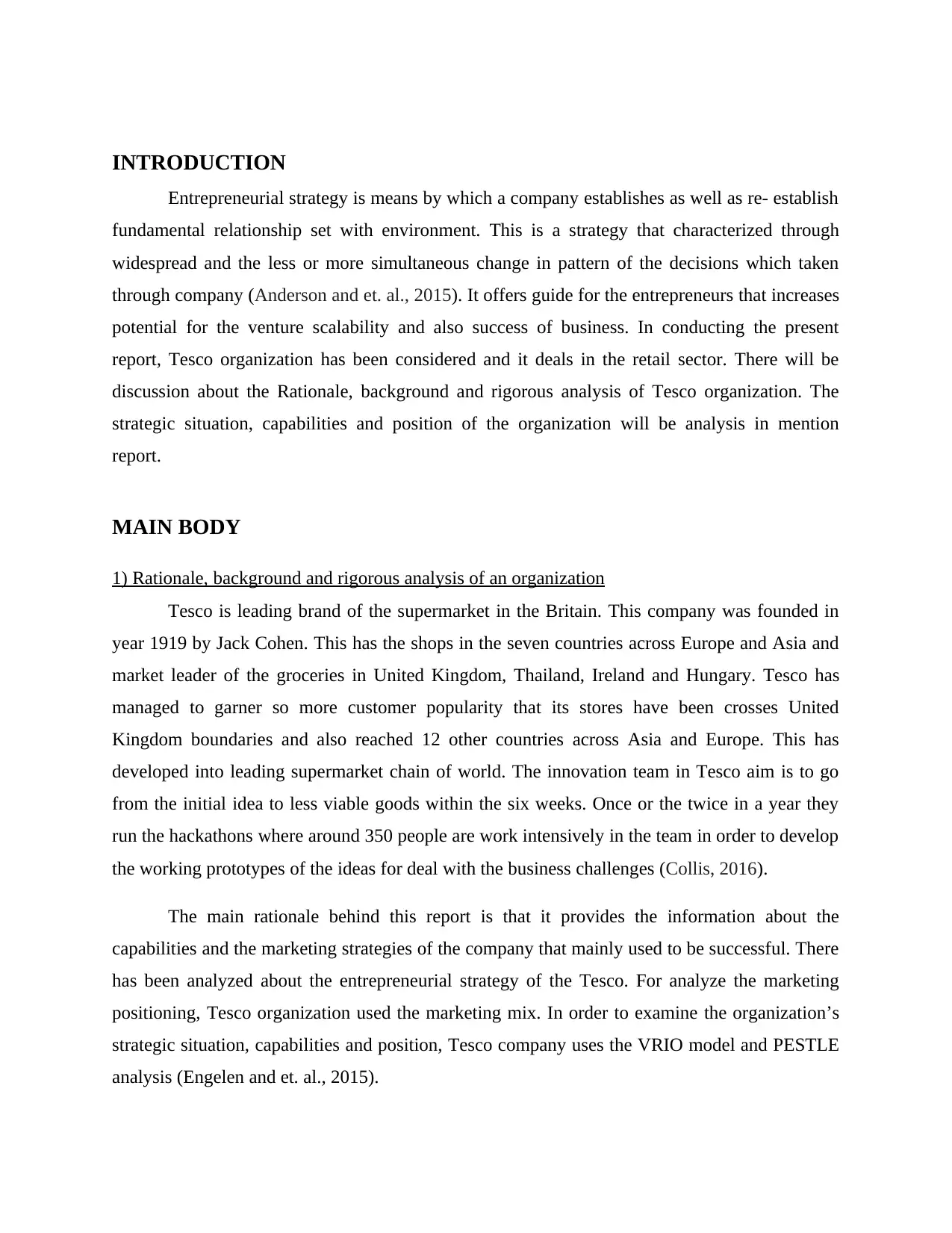
INTRODUCTION
Entrepreneurial strategy is means by which a company establishes as well as re- establish
fundamental relationship set with environment. This is a strategy that characterized through
widespread and the less or more simultaneous change in pattern of the decisions which taken
through company (Anderson and et. al., 2015). It offers guide for the entrepreneurs that increases
potential for the venture scalability and also success of business. In conducting the present
report, Tesco organization has been considered and it deals in the retail sector. There will be
discussion about the Rationale, background and rigorous analysis of Tesco organization. The
strategic situation, capabilities and position of the organization will be analysis in mention
report.
MAIN BODY
1) Rationale, background and rigorous analysis of an organization
Tesco is leading brand of the supermarket in the Britain. This company was founded in
year 1919 by Jack Cohen. This has the shops in the seven countries across Europe and Asia and
market leader of the groceries in United Kingdom, Thailand, Ireland and Hungary. Tesco has
managed to garner so more customer popularity that its stores have been crosses United
Kingdom boundaries and also reached 12 other countries across Asia and Europe. This has
developed into leading supermarket chain of world. The innovation team in Tesco aim is to go
from the initial idea to less viable goods within the six weeks. Once or the twice in a year they
run the hackathons where around 350 people are work intensively in the team in order to develop
the working prototypes of the ideas for deal with the business challenges (Collis, 2016).
The main rationale behind this report is that it provides the information about the
capabilities and the marketing strategies of the company that mainly used to be successful. There
has been analyzed about the entrepreneurial strategy of the Tesco. For analyze the marketing
positioning, Tesco organization used the marketing mix. In order to examine the organization’s
strategic situation, capabilities and position, Tesco company uses the VRIO model and PESTLE
analysis (Engelen and et. al., 2015).
Entrepreneurial strategy is means by which a company establishes as well as re- establish
fundamental relationship set with environment. This is a strategy that characterized through
widespread and the less or more simultaneous change in pattern of the decisions which taken
through company (Anderson and et. al., 2015). It offers guide for the entrepreneurs that increases
potential for the venture scalability and also success of business. In conducting the present
report, Tesco organization has been considered and it deals in the retail sector. There will be
discussion about the Rationale, background and rigorous analysis of Tesco organization. The
strategic situation, capabilities and position of the organization will be analysis in mention
report.
MAIN BODY
1) Rationale, background and rigorous analysis of an organization
Tesco is leading brand of the supermarket in the Britain. This company was founded in
year 1919 by Jack Cohen. This has the shops in the seven countries across Europe and Asia and
market leader of the groceries in United Kingdom, Thailand, Ireland and Hungary. Tesco has
managed to garner so more customer popularity that its stores have been crosses United
Kingdom boundaries and also reached 12 other countries across Asia and Europe. This has
developed into leading supermarket chain of world. The innovation team in Tesco aim is to go
from the initial idea to less viable goods within the six weeks. Once or the twice in a year they
run the hackathons where around 350 people are work intensively in the team in order to develop
the working prototypes of the ideas for deal with the business challenges (Collis, 2016).
The main rationale behind this report is that it provides the information about the
capabilities and the marketing strategies of the company that mainly used to be successful. There
has been analyzed about the entrepreneurial strategy of the Tesco. For analyze the marketing
positioning, Tesco organization used the marketing mix. In order to examine the organization’s
strategic situation, capabilities and position, Tesco company uses the VRIO model and PESTLE
analysis (Engelen and et. al., 2015).
⊘ This is a preview!⊘
Do you want full access?
Subscribe today to unlock all pages.

Trusted by 1+ million students worldwide
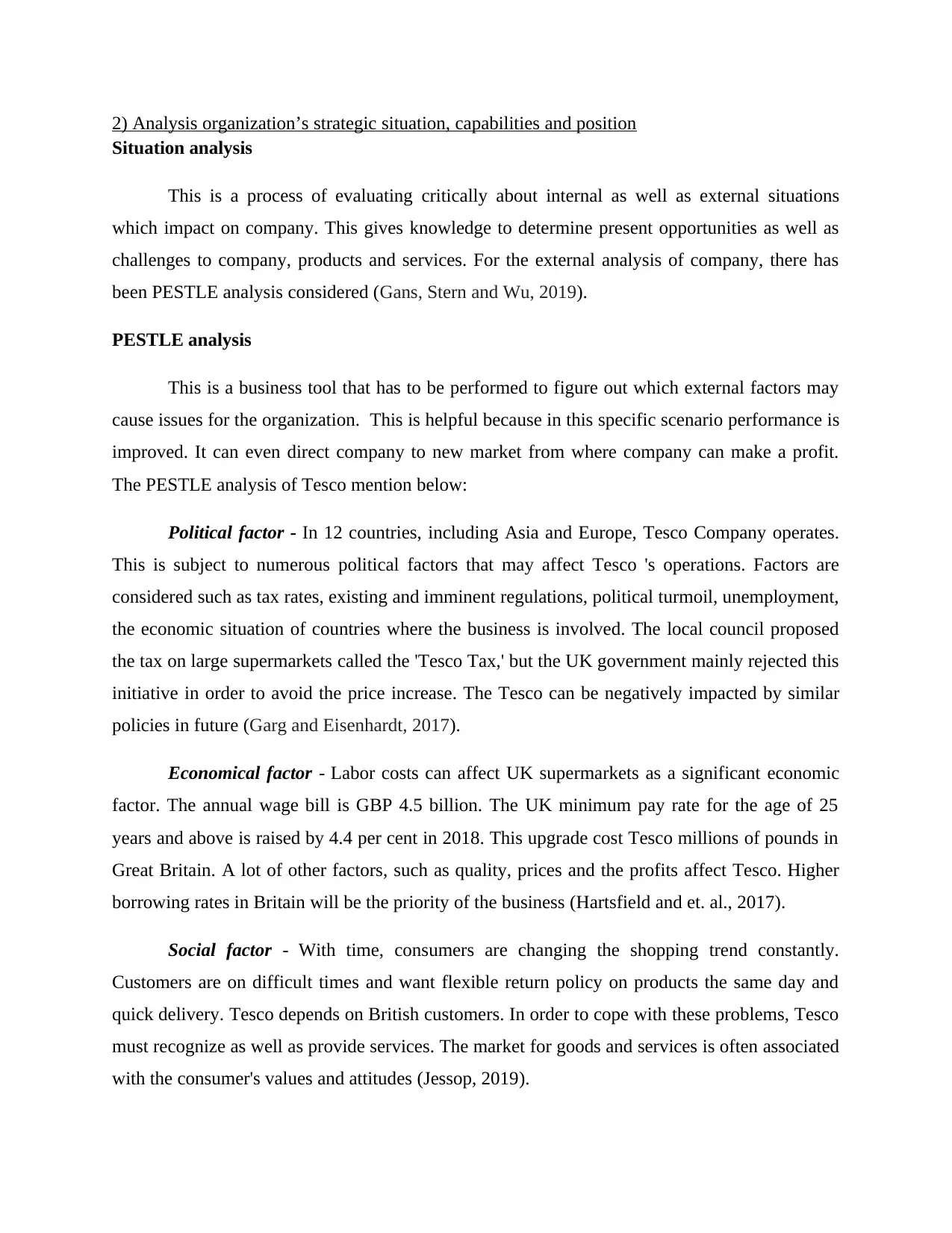
2) Analysis organization’s strategic situation, capabilities and position
Situation analysis
This is a process of evaluating critically about internal as well as external situations
which impact on company. This gives knowledge to determine present opportunities as well as
challenges to company, products and services. For the external analysis of company, there has
been PESTLE analysis considered (Gans, Stern and Wu, 2019).
PESTLE analysis
This is a business tool that has to be performed to figure out which external factors may
cause issues for the organization. This is helpful because in this specific scenario performance is
improved. It can even direct company to new market from where company can make a profit.
The PESTLE analysis of Tesco mention below:
Political factor - In 12 countries, including Asia and Europe, Tesco Company operates.
This is subject to numerous political factors that may affect Tesco 's operations. Factors are
considered such as tax rates, existing and imminent regulations, political turmoil, unemployment,
the economic situation of countries where the business is involved. The local council proposed
the tax on large supermarkets called the 'Tesco Tax,' but the UK government mainly rejected this
initiative in order to avoid the price increase. The Tesco can be negatively impacted by similar
policies in future (Garg and Eisenhardt, 2017).
Economical factor - Labor costs can affect UK supermarkets as a significant economic
factor. The annual wage bill is GBP 4.5 billion. The UK minimum pay rate for the age of 25
years and above is raised by 4.4 per cent in 2018. This upgrade cost Tesco millions of pounds in
Great Britain. A lot of other factors, such as quality, prices and the profits affect Tesco. Higher
borrowing rates in Britain will be the priority of the business (Hartsfield and et. al., 2017).
Social factor - With time, consumers are changing the shopping trend constantly.
Customers are on difficult times and want flexible return policy on products the same day and
quick delivery. Tesco depends on British customers. In order to cope with these problems, Tesco
must recognize as well as provide services. The market for goods and services is often associated
with the consumer's values and attitudes (Jessop, 2019).
Situation analysis
This is a process of evaluating critically about internal as well as external situations
which impact on company. This gives knowledge to determine present opportunities as well as
challenges to company, products and services. For the external analysis of company, there has
been PESTLE analysis considered (Gans, Stern and Wu, 2019).
PESTLE analysis
This is a business tool that has to be performed to figure out which external factors may
cause issues for the organization. This is helpful because in this specific scenario performance is
improved. It can even direct company to new market from where company can make a profit.
The PESTLE analysis of Tesco mention below:
Political factor - In 12 countries, including Asia and Europe, Tesco Company operates.
This is subject to numerous political factors that may affect Tesco 's operations. Factors are
considered such as tax rates, existing and imminent regulations, political turmoil, unemployment,
the economic situation of countries where the business is involved. The local council proposed
the tax on large supermarkets called the 'Tesco Tax,' but the UK government mainly rejected this
initiative in order to avoid the price increase. The Tesco can be negatively impacted by similar
policies in future (Garg and Eisenhardt, 2017).
Economical factor - Labor costs can affect UK supermarkets as a significant economic
factor. The annual wage bill is GBP 4.5 billion. The UK minimum pay rate for the age of 25
years and above is raised by 4.4 per cent in 2018. This upgrade cost Tesco millions of pounds in
Great Britain. A lot of other factors, such as quality, prices and the profits affect Tesco. Higher
borrowing rates in Britain will be the priority of the business (Hartsfield and et. al., 2017).
Social factor - With time, consumers are changing the shopping trend constantly.
Customers are on difficult times and want flexible return policy on products the same day and
quick delivery. Tesco depends on British customers. In order to cope with these problems, Tesco
must recognize as well as provide services. The market for goods and services is often associated
with the consumer's values and attitudes (Jessop, 2019).
Paraphrase This Document
Need a fresh take? Get an instant paraphrase of this document with our AI Paraphraser
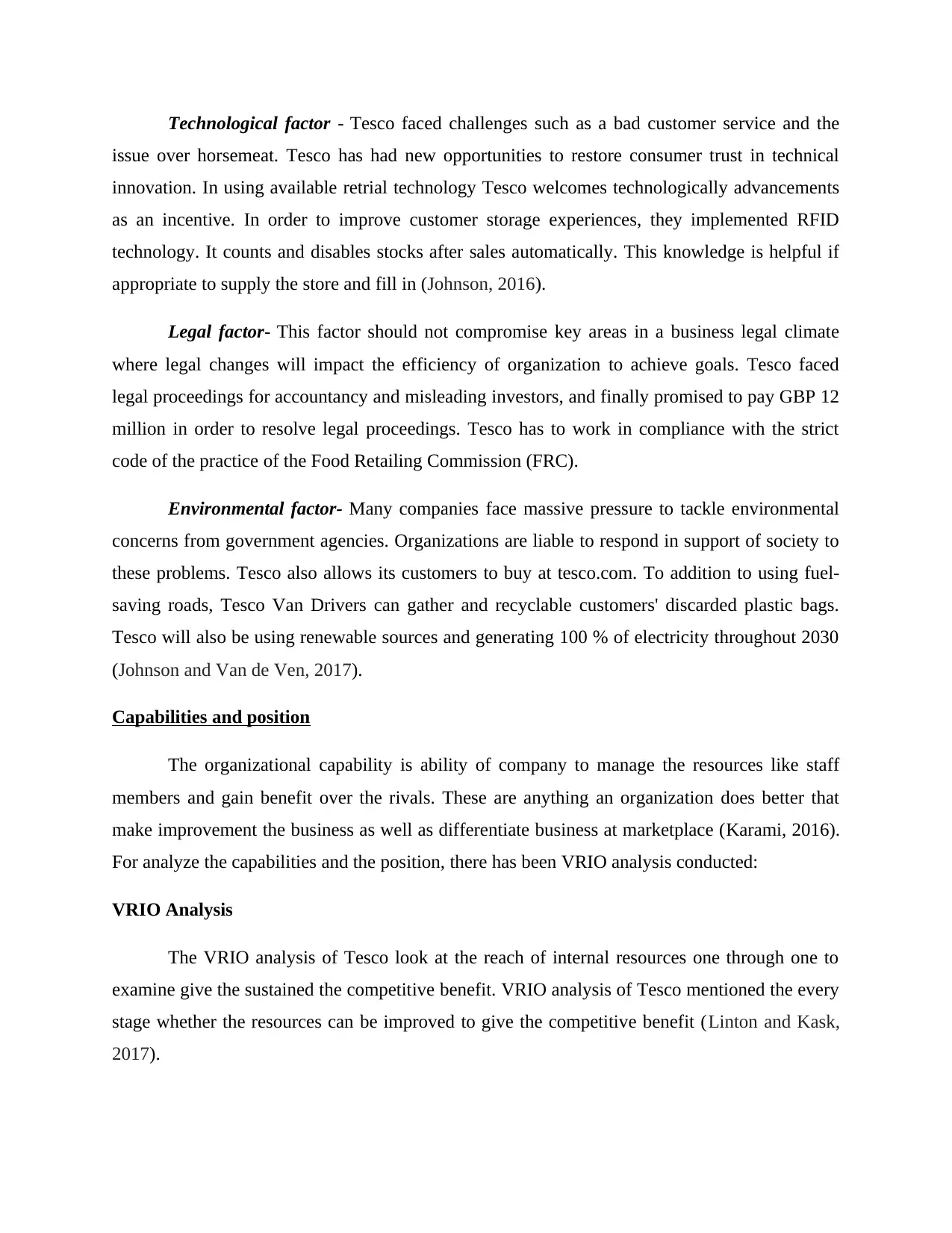
Technological factor - Tesco faced challenges such as a bad customer service and the
issue over horsemeat. Tesco has had new opportunities to restore consumer trust in technical
innovation. In using available retrial technology Tesco welcomes technologically advancements
as an incentive. In order to improve customer storage experiences, they implemented RFID
technology. It counts and disables stocks after sales automatically. This knowledge is helpful if
appropriate to supply the store and fill in (Johnson, 2016).
Legal factor- This factor should not compromise key areas in a business legal climate
where legal changes will impact the efficiency of organization to achieve goals. Tesco faced
legal proceedings for accountancy and misleading investors, and finally promised to pay GBP 12
million in order to resolve legal proceedings. Tesco has to work in compliance with the strict
code of the practice of the Food Retailing Commission (FRC).
Environmental factor- Many companies face massive pressure to tackle environmental
concerns from government agencies. Organizations are liable to respond in support of society to
these problems. Tesco also allows its customers to buy at tesco.com. To addition to using fuel-
saving roads, Tesco Van Drivers can gather and recyclable customers' discarded plastic bags.
Tesco will also be using renewable sources and generating 100 % of electricity throughout 2030
(Johnson and Van de Ven, 2017).
Capabilities and position
The organizational capability is ability of company to manage the resources like staff
members and gain benefit over the rivals. These are anything an organization does better that
make improvement the business as well as differentiate business at marketplace (Karami, 2016).
For analyze the capabilities and the position, there has been VRIO analysis conducted:
VRIO Analysis
The VRIO analysis of Tesco look at the reach of internal resources one through one to
examine give the sustained the competitive benefit. VRIO analysis of Tesco mentioned the every
stage whether the resources can be improved to give the competitive benefit (Linton and Kask,
2017).
issue over horsemeat. Tesco has had new opportunities to restore consumer trust in technical
innovation. In using available retrial technology Tesco welcomes technologically advancements
as an incentive. In order to improve customer storage experiences, they implemented RFID
technology. It counts and disables stocks after sales automatically. This knowledge is helpful if
appropriate to supply the store and fill in (Johnson, 2016).
Legal factor- This factor should not compromise key areas in a business legal climate
where legal changes will impact the efficiency of organization to achieve goals. Tesco faced
legal proceedings for accountancy and misleading investors, and finally promised to pay GBP 12
million in order to resolve legal proceedings. Tesco has to work in compliance with the strict
code of the practice of the Food Retailing Commission (FRC).
Environmental factor- Many companies face massive pressure to tackle environmental
concerns from government agencies. Organizations are liable to respond in support of society to
these problems. Tesco also allows its customers to buy at tesco.com. To addition to using fuel-
saving roads, Tesco Van Drivers can gather and recyclable customers' discarded plastic bags.
Tesco will also be using renewable sources and generating 100 % of electricity throughout 2030
(Johnson and Van de Ven, 2017).
Capabilities and position
The organizational capability is ability of company to manage the resources like staff
members and gain benefit over the rivals. These are anything an organization does better that
make improvement the business as well as differentiate business at marketplace (Karami, 2016).
For analyze the capabilities and the position, there has been VRIO analysis conducted:
VRIO Analysis
The VRIO analysis of Tesco look at the reach of internal resources one through one to
examine give the sustained the competitive benefit. VRIO analysis of Tesco mentioned the every
stage whether the resources can be improved to give the competitive benefit (Linton and Kask,
2017).

Resources Valuable Rare Imitate Organised
Financial
resources
Yes Yes Yes Yes
Consumer
competition
Yes Yes No
Employees skills Yes Yes Yes No
Human resource Yes Yes Yes Yes
Valuable- As valuable help to invest in external markets, Tesco Plc's financial resources
are highly important. These allow Tesco Plc to tackle external threats as well. The local food
items of Tesco are valuable resource because they are much diversified. This gives consumers
high perceived interest. They are often valued much more consumer competition. The staff
members of Tesco Plc are a valuable tool for the company. Substantial part of workforce is better
skilled, which means that organization produces better output. Staffs are always committed to the
company and retention rates are high.
Rare- According to VRIO evaluation from Tesco Plc, financial resources from Tesco Plc
are rare. Only a few businesses have strong financial resources. Local food items as described in
the Tesco Plc VRIO Analysis are to be found not unusual. Many rivals can easily supply these in
market. This ensures that rivals can make use of such services as Tesco Plc does and avoid
comparative benefit. This results in the price balance of Tesco Plc with local food items. Tesco
Plc will also this tool as resource is valuable (Lumpkin and et. al., 2015).
Imitate- As identified in the Tesco Plc VRIO Analysis, Tesco's financial resources are
costly to imitate. Through long-lasting profit, these resources were acquired by the company. It
is not that expensive to imitate food products as found in Tesco Plc’s VRIO analysis.
Competitors may also gain these if they are spending heavily in research and development. There
is no need for several years of experience. Consequently, Tesco Plc's local food goods give it a
sustainable temporary advantage, which competitive will achieve only long-term.
Financial
resources
Yes Yes Yes Yes
Consumer
competition
Yes Yes No
Employees skills Yes Yes Yes No
Human resource Yes Yes Yes Yes
Valuable- As valuable help to invest in external markets, Tesco Plc's financial resources
are highly important. These allow Tesco Plc to tackle external threats as well. The local food
items of Tesco are valuable resource because they are much diversified. This gives consumers
high perceived interest. They are often valued much more consumer competition. The staff
members of Tesco Plc are a valuable tool for the company. Substantial part of workforce is better
skilled, which means that organization produces better output. Staffs are always committed to the
company and retention rates are high.
Rare- According to VRIO evaluation from Tesco Plc, financial resources from Tesco Plc
are rare. Only a few businesses have strong financial resources. Local food items as described in
the Tesco Plc VRIO Analysis are to be found not unusual. Many rivals can easily supply these in
market. This ensures that rivals can make use of such services as Tesco Plc does and avoid
comparative benefit. This results in the price balance of Tesco Plc with local food items. Tesco
Plc will also this tool as resource is valuable (Lumpkin and et. al., 2015).
Imitate- As identified in the Tesco Plc VRIO Analysis, Tesco's financial resources are
costly to imitate. Through long-lasting profit, these resources were acquired by the company. It
is not that expensive to imitate food products as found in Tesco Plc’s VRIO analysis.
Competitors may also gain these if they are spending heavily in research and development. There
is no need for several years of experience. Consequently, Tesco Plc's local food goods give it a
sustainable temporary advantage, which competitive will achieve only long-term.
⊘ This is a preview!⊘
Do you want full access?
Subscribe today to unlock all pages.

Trusted by 1+ million students worldwide
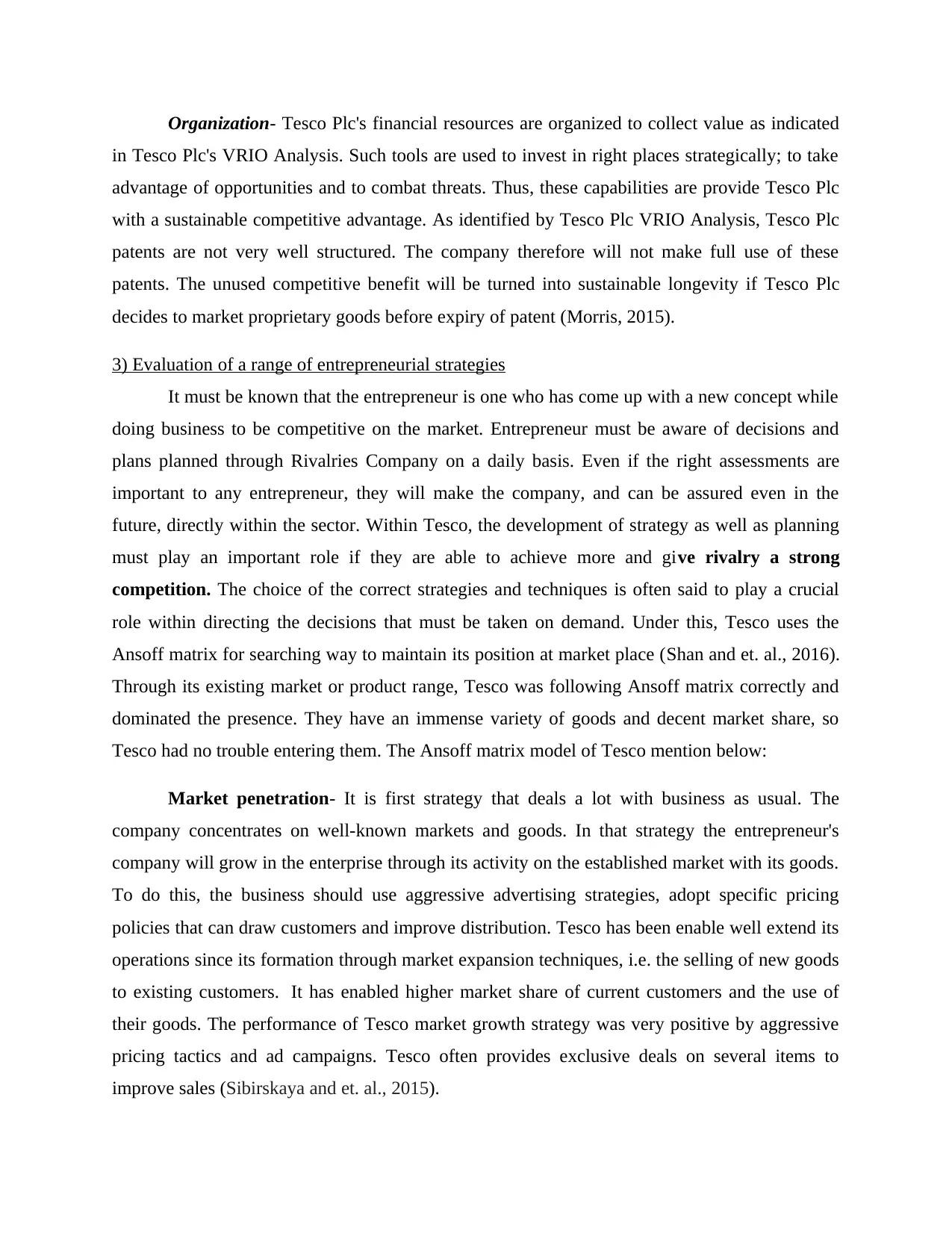
Organization- Tesco Plc's financial resources are organized to collect value as indicated
in Tesco Plc's VRIO Analysis. Such tools are used to invest in right places strategically; to take
advantage of opportunities and to combat threats. Thus, these capabilities are provide Tesco Plc
with a sustainable competitive advantage. As identified by Tesco Plc VRIO Analysis, Tesco Plc
patents are not very well structured. The company therefore will not make full use of these
patents. The unused competitive benefit will be turned into sustainable longevity if Tesco Plc
decides to market proprietary goods before expiry of patent (Morris, 2015).
3) Evaluation of a range of entrepreneurial strategies
It must be known that the entrepreneur is one who has come up with a new concept while
doing business to be competitive on the market. Entrepreneur must be aware of decisions and
plans planned through Rivalries Company on a daily basis. Even if the right assessments are
important to any entrepreneur, they will make the company, and can be assured even in the
future, directly within the sector. Within Tesco, the development of strategy as well as planning
must play an important role if they are able to achieve more and give rivalry a strong
competition. The choice of the correct strategies and techniques is often said to play a crucial
role within directing the decisions that must be taken on demand. Under this, Tesco uses the
Ansoff matrix for searching way to maintain its position at market place (Shan and et. al., 2016).
Through its existing market or product range, Tesco was following Ansoff matrix correctly and
dominated the presence. They have an immense variety of goods and decent market share, so
Tesco had no trouble entering them. The Ansoff matrix model of Tesco mention below:
Market penetration- It is first strategy that deals a lot with business as usual. The
company concentrates on well-known markets and goods. In that strategy the entrepreneur's
company will grow in the enterprise through its activity on the established market with its goods.
To do this, the business should use aggressive advertising strategies, adopt specific pricing
policies that can draw customers and improve distribution. Tesco has been enable well extend its
operations since its formation through market expansion techniques, i.e. the selling of new goods
to existing customers. It has enabled higher market share of current customers and the use of
their goods. The performance of Tesco market growth strategy was very positive by aggressive
pricing tactics and ad campaigns. Tesco often provides exclusive deals on several items to
improve sales (Sibirskaya and et. al., 2015).
in Tesco Plc's VRIO Analysis. Such tools are used to invest in right places strategically; to take
advantage of opportunities and to combat threats. Thus, these capabilities are provide Tesco Plc
with a sustainable competitive advantage. As identified by Tesco Plc VRIO Analysis, Tesco Plc
patents are not very well structured. The company therefore will not make full use of these
patents. The unused competitive benefit will be turned into sustainable longevity if Tesco Plc
decides to market proprietary goods before expiry of patent (Morris, 2015).
3) Evaluation of a range of entrepreneurial strategies
It must be known that the entrepreneur is one who has come up with a new concept while
doing business to be competitive on the market. Entrepreneur must be aware of decisions and
plans planned through Rivalries Company on a daily basis. Even if the right assessments are
important to any entrepreneur, they will make the company, and can be assured even in the
future, directly within the sector. Within Tesco, the development of strategy as well as planning
must play an important role if they are able to achieve more and give rivalry a strong
competition. The choice of the correct strategies and techniques is often said to play a crucial
role within directing the decisions that must be taken on demand. Under this, Tesco uses the
Ansoff matrix for searching way to maintain its position at market place (Shan and et. al., 2016).
Through its existing market or product range, Tesco was following Ansoff matrix correctly and
dominated the presence. They have an immense variety of goods and decent market share, so
Tesco had no trouble entering them. The Ansoff matrix model of Tesco mention below:
Market penetration- It is first strategy that deals a lot with business as usual. The
company concentrates on well-known markets and goods. In that strategy the entrepreneur's
company will grow in the enterprise through its activity on the established market with its goods.
To do this, the business should use aggressive advertising strategies, adopt specific pricing
policies that can draw customers and improve distribution. Tesco has been enable well extend its
operations since its formation through market expansion techniques, i.e. the selling of new goods
to existing customers. It has enabled higher market share of current customers and the use of
their goods. The performance of Tesco market growth strategy was very positive by aggressive
pricing tactics and ad campaigns. Tesco often provides exclusive deals on several items to
improve sales (Sibirskaya and et. al., 2015).
Paraphrase This Document
Need a fresh take? Get an instant paraphrase of this document with our AI Paraphraser
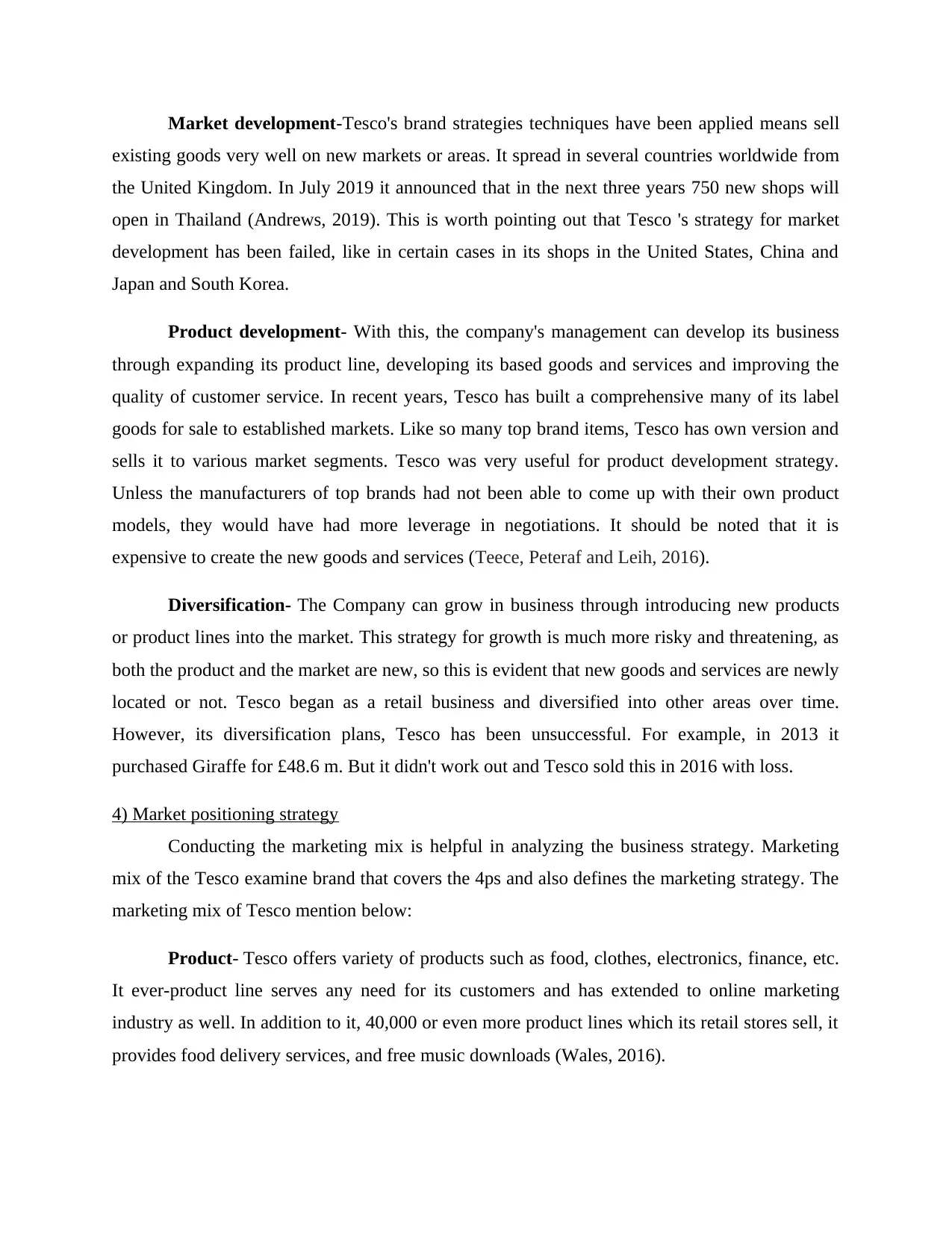
Market development-Tesco's brand strategies techniques have been applied means sell
existing goods very well on new markets or areas. It spread in several countries worldwide from
the United Kingdom. In July 2019 it announced that in the next three years 750 new shops will
open in Thailand (Andrews, 2019). This is worth pointing out that Tesco 's strategy for market
development has been failed, like in certain cases in its shops in the United States, China and
Japan and South Korea.
Product development- With this, the company's management can develop its business
through expanding its product line, developing its based goods and services and improving the
quality of customer service. In recent years, Tesco has built a comprehensive many of its label
goods for sale to established markets. Like so many top brand items, Tesco has own version and
sells it to various market segments. Tesco was very useful for product development strategy.
Unless the manufacturers of top brands had not been able to come up with their own product
models, they would have had more leverage in negotiations. It should be noted that it is
expensive to create the new goods and services (Teece, Peteraf and Leih, 2016).
Diversification- The Company can grow in business through introducing new products
or product lines into the market. This strategy for growth is much more risky and threatening, as
both the product and the market are new, so this is evident that new goods and services are newly
located or not. Tesco began as a retail business and diversified into other areas over time.
However, its diversification plans, Tesco has been unsuccessful. For example, in 2013 it
purchased Giraffe for £48.6 m. But it didn't work out and Tesco sold this in 2016 with loss.
4) Market positioning strategy
Conducting the marketing mix is helpful in analyzing the business strategy. Marketing
mix of the Tesco examine brand that covers the 4ps and also defines the marketing strategy. The
marketing mix of Tesco mention below:
Product- Tesco offers variety of products such as food, clothes, electronics, finance, etc.
It ever-product line serves any need for its customers and has extended to online marketing
industry as well. In addition to it, 40,000 or even more product lines which its retail stores sell, it
provides food delivery services, and free music downloads (Wales, 2016).
existing goods very well on new markets or areas. It spread in several countries worldwide from
the United Kingdom. In July 2019 it announced that in the next three years 750 new shops will
open in Thailand (Andrews, 2019). This is worth pointing out that Tesco 's strategy for market
development has been failed, like in certain cases in its shops in the United States, China and
Japan and South Korea.
Product development- With this, the company's management can develop its business
through expanding its product line, developing its based goods and services and improving the
quality of customer service. In recent years, Tesco has built a comprehensive many of its label
goods for sale to established markets. Like so many top brand items, Tesco has own version and
sells it to various market segments. Tesco was very useful for product development strategy.
Unless the manufacturers of top brands had not been able to come up with their own product
models, they would have had more leverage in negotiations. It should be noted that it is
expensive to create the new goods and services (Teece, Peteraf and Leih, 2016).
Diversification- The Company can grow in business through introducing new products
or product lines into the market. This strategy for growth is much more risky and threatening, as
both the product and the market are new, so this is evident that new goods and services are newly
located or not. Tesco began as a retail business and diversified into other areas over time.
However, its diversification plans, Tesco has been unsuccessful. For example, in 2013 it
purchased Giraffe for £48.6 m. But it didn't work out and Tesco sold this in 2016 with loss.
4) Market positioning strategy
Conducting the marketing mix is helpful in analyzing the business strategy. Marketing
mix of the Tesco examine brand that covers the 4ps and also defines the marketing strategy. The
marketing mix of Tesco mention below:
Product- Tesco offers variety of products such as food, clothes, electronics, finance, etc.
It ever-product line serves any need for its customers and has extended to online marketing
industry as well. In addition to it, 40,000 or even more product lines which its retail stores sell, it
provides food delivery services, and free music downloads (Wales, 2016).
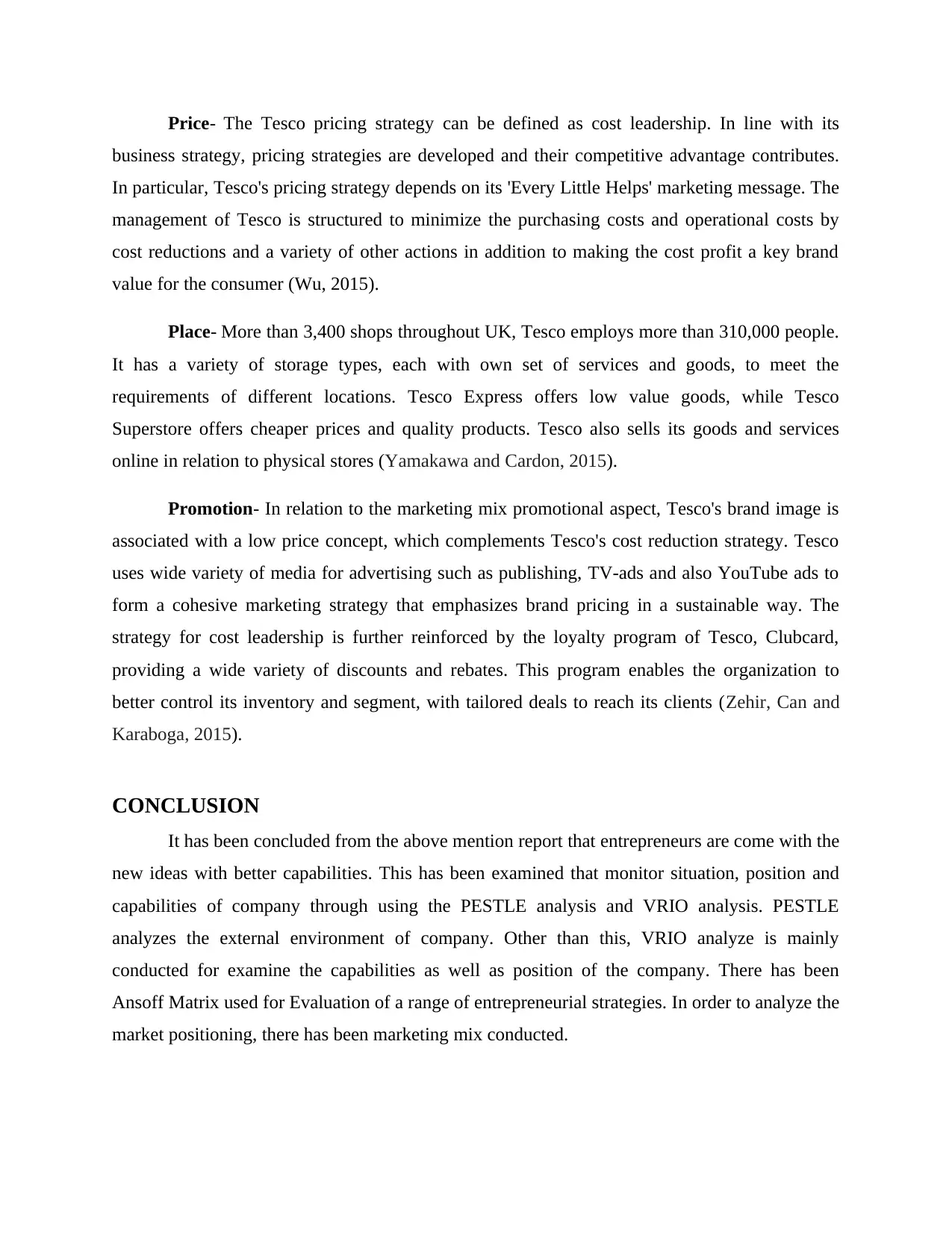
Price- The Tesco pricing strategy can be defined as cost leadership. In line with its
business strategy, pricing strategies are developed and their competitive advantage contributes.
In particular, Tesco's pricing strategy depends on its 'Every Little Helps' marketing message. The
management of Tesco is structured to minimize the purchasing costs and operational costs by
cost reductions and a variety of other actions in addition to making the cost profit a key brand
value for the consumer (Wu, 2015).
Place- More than 3,400 shops throughout UK, Tesco employs more than 310,000 people.
It has a variety of storage types, each with own set of services and goods, to meet the
requirements of different locations. Tesco Express offers low value goods, while Tesco
Superstore offers cheaper prices and quality products. Tesco also sells its goods and services
online in relation to physical stores (Yamakawa and Cardon, 2015).
Promotion- In relation to the marketing mix promotional aspect, Tesco's brand image is
associated with a low price concept, which complements Tesco's cost reduction strategy. Tesco
uses wide variety of media for advertising such as publishing, TV-ads and also YouTube ads to
form a cohesive marketing strategy that emphasizes brand pricing in a sustainable way. The
strategy for cost leadership is further reinforced by the loyalty program of Tesco, Clubcard,
providing a wide variety of discounts and rebates. This program enables the organization to
better control its inventory and segment, with tailored deals to reach its clients (Zehir, Can and
Karaboga, 2015).
CONCLUSION
It has been concluded from the above mention report that entrepreneurs are come with the
new ideas with better capabilities. This has been examined that monitor situation, position and
capabilities of company through using the PESTLE analysis and VRIO analysis. PESTLE
analyzes the external environment of company. Other than this, VRIO analyze is mainly
conducted for examine the capabilities as well as position of the company. There has been
Ansoff Matrix used for Evaluation of a range of entrepreneurial strategies. In order to analyze the
market positioning, there has been marketing mix conducted.
business strategy, pricing strategies are developed and their competitive advantage contributes.
In particular, Tesco's pricing strategy depends on its 'Every Little Helps' marketing message. The
management of Tesco is structured to minimize the purchasing costs and operational costs by
cost reductions and a variety of other actions in addition to making the cost profit a key brand
value for the consumer (Wu, 2015).
Place- More than 3,400 shops throughout UK, Tesco employs more than 310,000 people.
It has a variety of storage types, each with own set of services and goods, to meet the
requirements of different locations. Tesco Express offers low value goods, while Tesco
Superstore offers cheaper prices and quality products. Tesco also sells its goods and services
online in relation to physical stores (Yamakawa and Cardon, 2015).
Promotion- In relation to the marketing mix promotional aspect, Tesco's brand image is
associated with a low price concept, which complements Tesco's cost reduction strategy. Tesco
uses wide variety of media for advertising such as publishing, TV-ads and also YouTube ads to
form a cohesive marketing strategy that emphasizes brand pricing in a sustainable way. The
strategy for cost leadership is further reinforced by the loyalty program of Tesco, Clubcard,
providing a wide variety of discounts and rebates. This program enables the organization to
better control its inventory and segment, with tailored deals to reach its clients (Zehir, Can and
Karaboga, 2015).
CONCLUSION
It has been concluded from the above mention report that entrepreneurs are come with the
new ideas with better capabilities. This has been examined that monitor situation, position and
capabilities of company through using the PESTLE analysis and VRIO analysis. PESTLE
analyzes the external environment of company. Other than this, VRIO analyze is mainly
conducted for examine the capabilities as well as position of the company. There has been
Ansoff Matrix used for Evaluation of a range of entrepreneurial strategies. In order to analyze the
market positioning, there has been marketing mix conducted.
⊘ This is a preview!⊘
Do you want full access?
Subscribe today to unlock all pages.

Trusted by 1+ million students worldwide
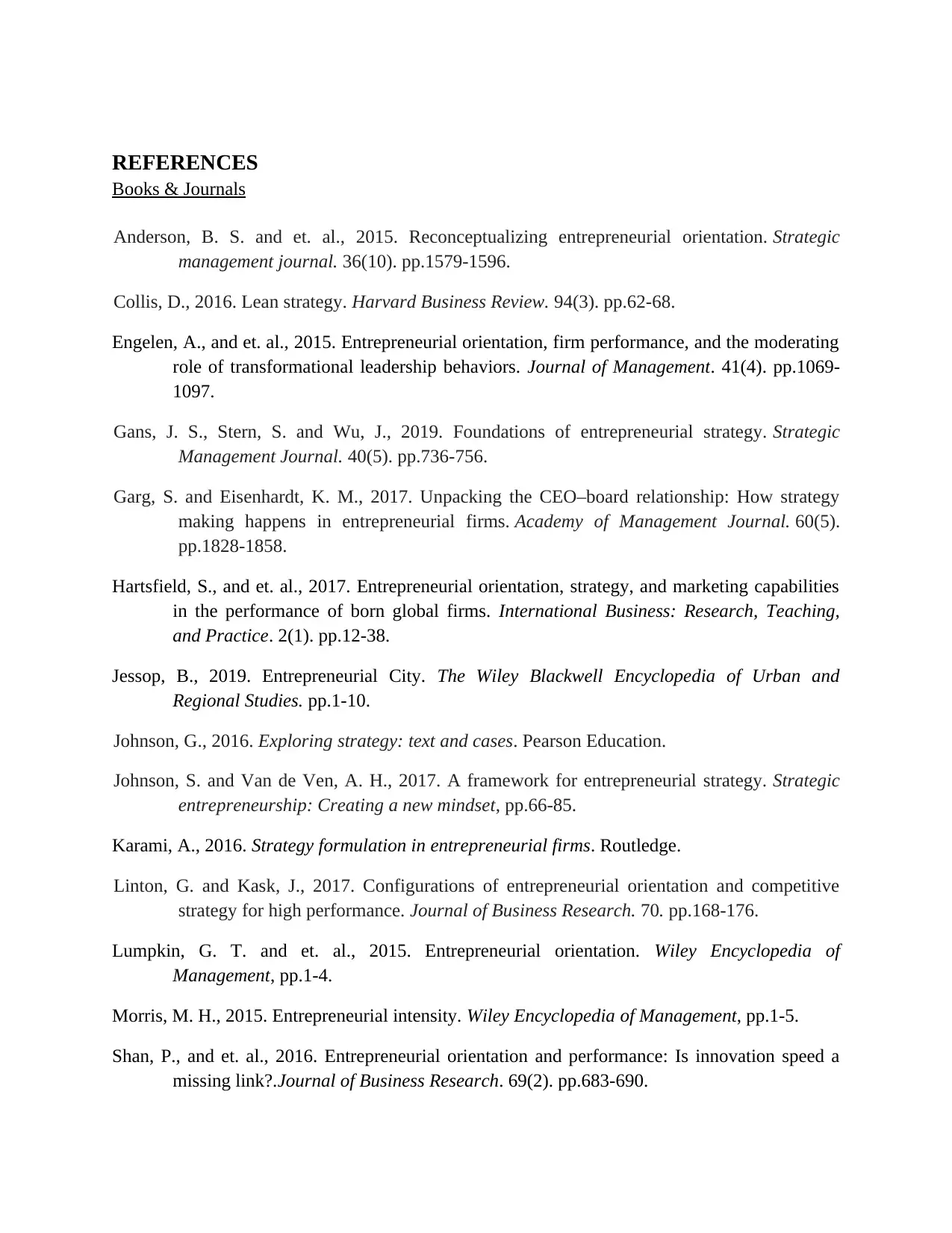
REFERENCES
Books & Journals
Anderson, B. S. and et. al., 2015. Reconceptualizing entrepreneurial orientation. Strategic
management journal. 36(10). pp.1579-1596.
Collis, D., 2016. Lean strategy. Harvard Business Review. 94(3). pp.62-68.
Engelen, A., and et. al., 2015. Entrepreneurial orientation, firm performance, and the moderating
role of transformational leadership behaviors. Journal of Management. 41(4). pp.1069-
1097.
Gans, J. S., Stern, S. and Wu, J., 2019. Foundations of entrepreneurial strategy. Strategic
Management Journal. 40(5). pp.736-756.
Garg, S. and Eisenhardt, K. M., 2017. Unpacking the CEO–board relationship: How strategy
making happens in entrepreneurial firms. Academy of Management Journal. 60(5).
pp.1828-1858.
Hartsfield, S., and et. al., 2017. Entrepreneurial orientation, strategy, and marketing capabilities
in the performance of born global firms. International Business: Research, Teaching,
and Practice. 2(1). pp.12-38.
Jessop, B., 2019. Entrepreneurial City. The Wiley Blackwell Encyclopedia of Urban and
Regional Studies. pp.1-10.
Johnson, G., 2016. Exploring strategy: text and cases. Pearson Education.
Johnson, S. and Van de Ven, A. H., 2017. A framework for entrepreneurial strategy. Strategic
entrepreneurship: Creating a new mindset, pp.66-85.
Karami, A., 2016. Strategy formulation in entrepreneurial firms. Routledge.
Linton, G. and Kask, J., 2017. Configurations of entrepreneurial orientation and competitive
strategy for high performance. Journal of Business Research. 70. pp.168-176.
Lumpkin, G. T. and et. al., 2015. Entrepreneurial orientation. Wiley Encyclopedia of
Management, pp.1-4.
Morris, M. H., 2015. Entrepreneurial intensity. Wiley Encyclopedia of Management, pp.1-5.
Shan, P., and et. al., 2016. Entrepreneurial orientation and performance: Is innovation speed a
missing link?.Journal of Business Research. 69(2). pp.683-690.
Books & Journals
Anderson, B. S. and et. al., 2015. Reconceptualizing entrepreneurial orientation. Strategic
management journal. 36(10). pp.1579-1596.
Collis, D., 2016. Lean strategy. Harvard Business Review. 94(3). pp.62-68.
Engelen, A., and et. al., 2015. Entrepreneurial orientation, firm performance, and the moderating
role of transformational leadership behaviors. Journal of Management. 41(4). pp.1069-
1097.
Gans, J. S., Stern, S. and Wu, J., 2019. Foundations of entrepreneurial strategy. Strategic
Management Journal. 40(5). pp.736-756.
Garg, S. and Eisenhardt, K. M., 2017. Unpacking the CEO–board relationship: How strategy
making happens in entrepreneurial firms. Academy of Management Journal. 60(5).
pp.1828-1858.
Hartsfield, S., and et. al., 2017. Entrepreneurial orientation, strategy, and marketing capabilities
in the performance of born global firms. International Business: Research, Teaching,
and Practice. 2(1). pp.12-38.
Jessop, B., 2019. Entrepreneurial City. The Wiley Blackwell Encyclopedia of Urban and
Regional Studies. pp.1-10.
Johnson, G., 2016. Exploring strategy: text and cases. Pearson Education.
Johnson, S. and Van de Ven, A. H., 2017. A framework for entrepreneurial strategy. Strategic
entrepreneurship: Creating a new mindset, pp.66-85.
Karami, A., 2016. Strategy formulation in entrepreneurial firms. Routledge.
Linton, G. and Kask, J., 2017. Configurations of entrepreneurial orientation and competitive
strategy for high performance. Journal of Business Research. 70. pp.168-176.
Lumpkin, G. T. and et. al., 2015. Entrepreneurial orientation. Wiley Encyclopedia of
Management, pp.1-4.
Morris, M. H., 2015. Entrepreneurial intensity. Wiley Encyclopedia of Management, pp.1-5.
Shan, P., and et. al., 2016. Entrepreneurial orientation and performance: Is innovation speed a
missing link?.Journal of Business Research. 69(2). pp.683-690.
Paraphrase This Document
Need a fresh take? Get an instant paraphrase of this document with our AI Paraphraser
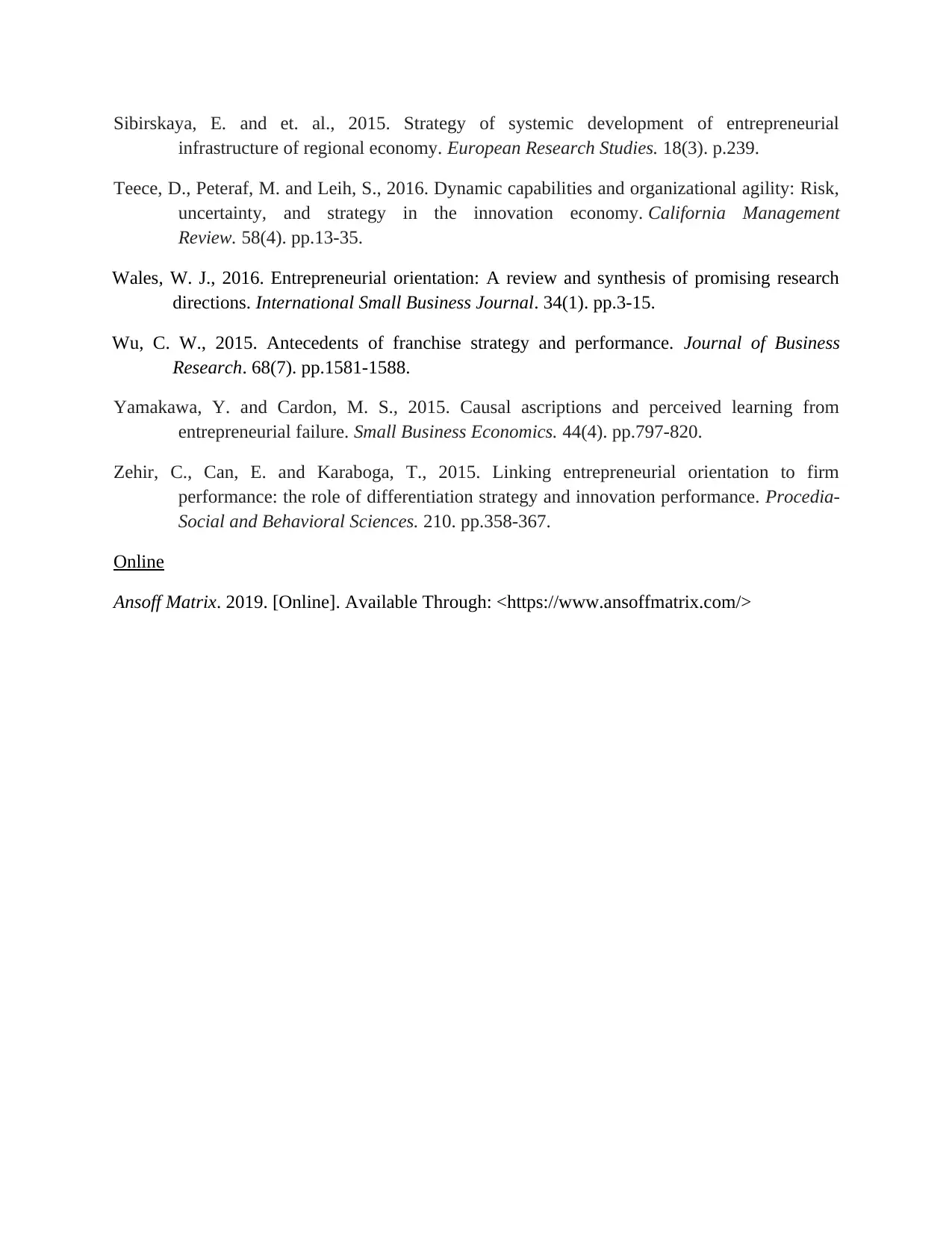
Sibirskaya, E. and et. al., 2015. Strategy of systemic development of entrepreneurial
infrastructure of regional economy. European Research Studies. 18(3). p.239.
Teece, D., Peteraf, M. and Leih, S., 2016. Dynamic capabilities and organizational agility: Risk,
uncertainty, and strategy in the innovation economy. California Management
Review. 58(4). pp.13-35.
Wales, W. J., 2016. Entrepreneurial orientation: A review and synthesis of promising research
directions. International Small Business Journal. 34(1). pp.3-15.
Wu, C. W., 2015. Antecedents of franchise strategy and performance. Journal of Business
Research. 68(7). pp.1581-1588.
Yamakawa, Y. and Cardon, M. S., 2015. Causal ascriptions and perceived learning from
entrepreneurial failure. Small Business Economics. 44(4). pp.797-820.
Zehir, C., Can, E. and Karaboga, T., 2015. Linking entrepreneurial orientation to firm
performance: the role of differentiation strategy and innovation performance. Procedia-
Social and Behavioral Sciences. 210. pp.358-367.
Online
Ansoff Matrix. 2019. [Online]. Available Through: <https://www.ansoffmatrix.com/>
infrastructure of regional economy. European Research Studies. 18(3). p.239.
Teece, D., Peteraf, M. and Leih, S., 2016. Dynamic capabilities and organizational agility: Risk,
uncertainty, and strategy in the innovation economy. California Management
Review. 58(4). pp.13-35.
Wales, W. J., 2016. Entrepreneurial orientation: A review and synthesis of promising research
directions. International Small Business Journal. 34(1). pp.3-15.
Wu, C. W., 2015. Antecedents of franchise strategy and performance. Journal of Business
Research. 68(7). pp.1581-1588.
Yamakawa, Y. and Cardon, M. S., 2015. Causal ascriptions and perceived learning from
entrepreneurial failure. Small Business Economics. 44(4). pp.797-820.
Zehir, C., Can, E. and Karaboga, T., 2015. Linking entrepreneurial orientation to firm
performance: the role of differentiation strategy and innovation performance. Procedia-
Social and Behavioral Sciences. 210. pp.358-367.
Online
Ansoff Matrix. 2019. [Online]. Available Through: <https://www.ansoffmatrix.com/>
1 out of 11
Related Documents
Your All-in-One AI-Powered Toolkit for Academic Success.
+13062052269
info@desklib.com
Available 24*7 on WhatsApp / Email
![[object Object]](/_next/static/media/star-bottom.7253800d.svg)
Unlock your academic potential
Copyright © 2020–2025 A2Z Services. All Rights Reserved. Developed and managed by ZUCOL.



